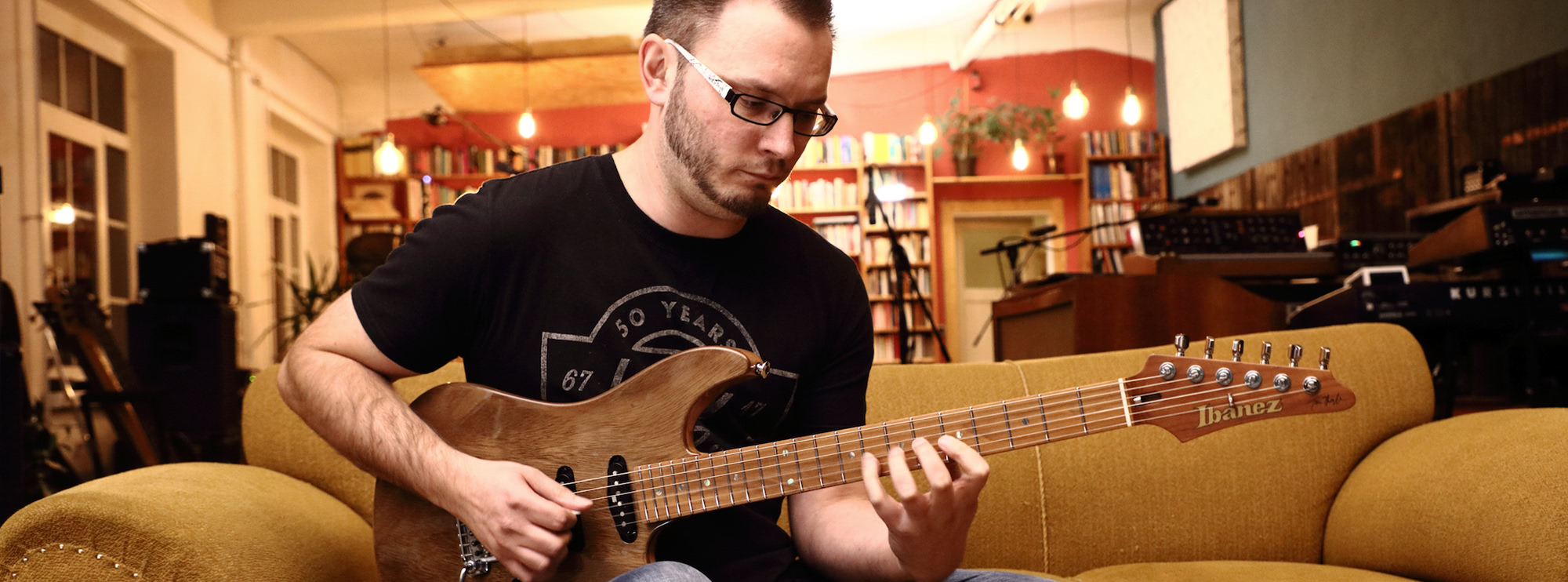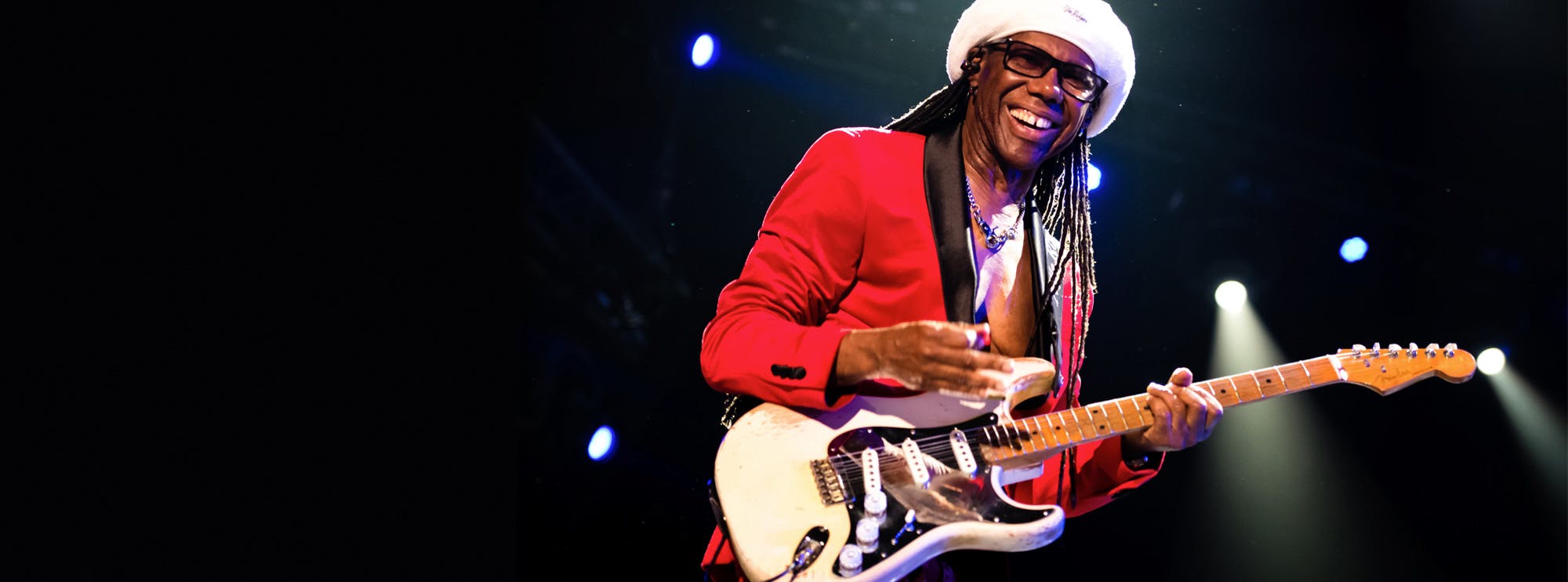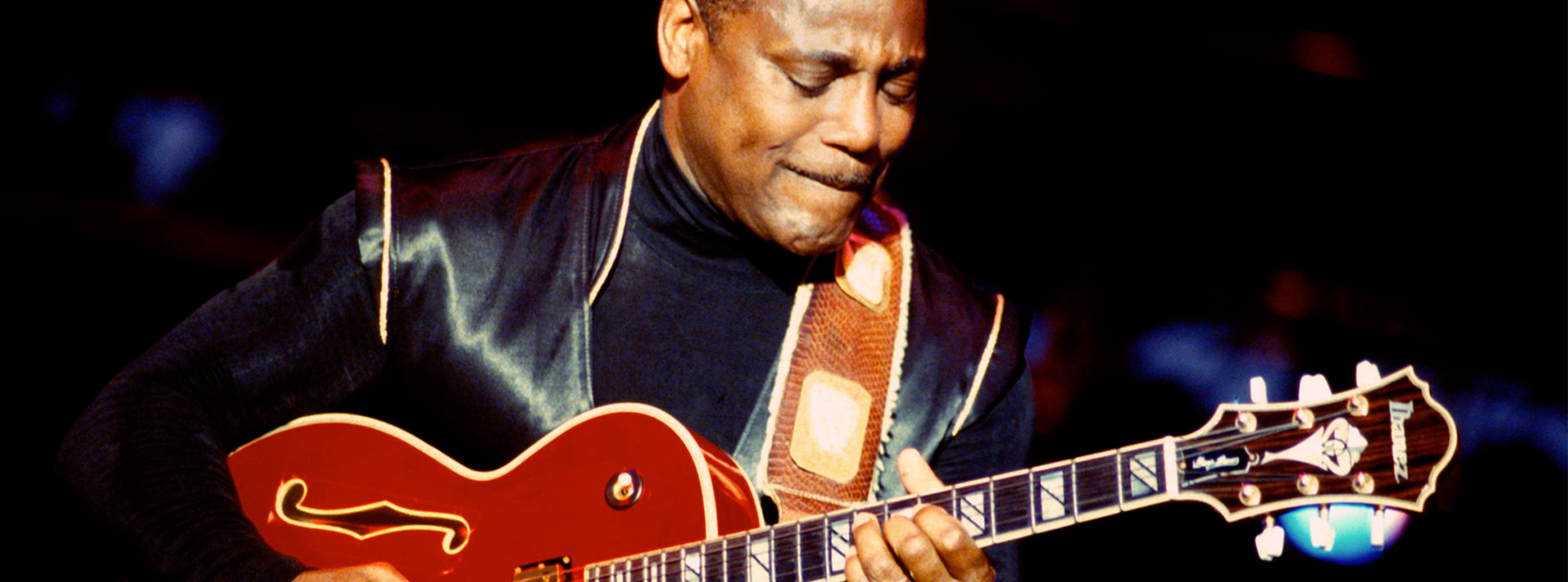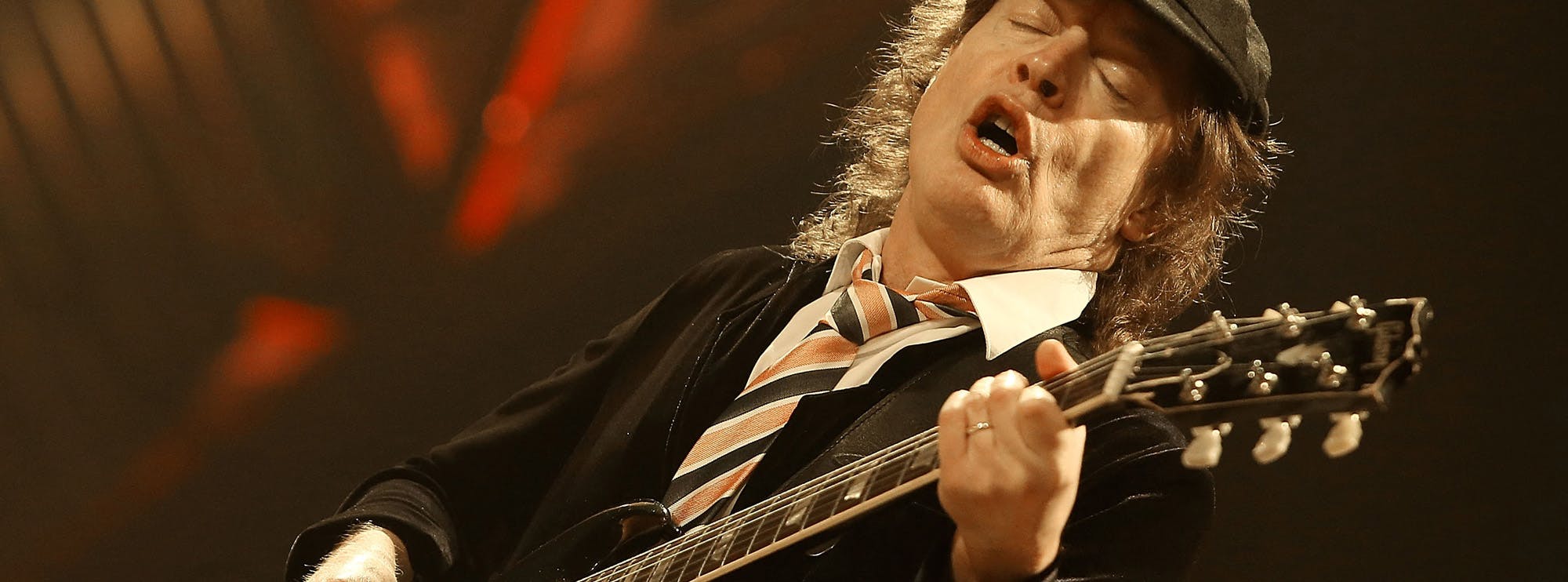"If it makes the guitar sound like some other guitar, then forget it," Satriani says and the Ibanez JS series is certainly a unique family - a quality helped by his choice of pickups. Though not all models share the distinctive characteristics of the DiMarzio 'Fred' Alnico humbucker in the bridge position, with a DiMarzio PAF-PRO at the neck, as has the classic JS1000 reviewed this issue, they will all allow players to get somewhere close to his artist's palette of tonal effects. Key, too, is the Ibanez take on floating trem systems. The dedicated Satriani fan may save-up for the JS1000 but if price is a problem, Ibanez has introduced less costly models that will help you get close, like the JS100 which we also review in this issue.
Using the (Ibanez) 540 as a starting point, the team slowly evolved towards a guitar that would allow this astonishing virtuoso to do everything he could do.
Danny Gill
Once you've got a guitar and amp you then need to start looking at your pedal board. Your amp needs to have huge headroom and dynamics to handle the transients, but essentially needs to be clean. Your guitar needs a huge output and an advanced trem system - but effects are your key. In the past, a Satriani array might have called for a Cry Baby wah, a Digitech Whammy and a clutch of Boss pedals including a DS-1, CH-1, CE-2, DD-2 and DD-3, but these days Satch has made it easy for his fans by teaming-up with Vox to introduce a range of four endorsed pedals which - as you'd expect - we have also reviewed in this month's GI.
Still not content in your quest for the perfect Satriani ensemble? Fear not - the great man uses and endorses D'Addario strings and a host of accessories like straps and picks from D'Addario's Planet Waves accessories brand. All you need to add is that blistering musical talent. Chord Extensions
Though Joe Satriani's fame is based on his blistering solo work, he's also a master of chords. Danny Gill demonstrates a neat way of following in Joe's footsteps.
A great way to add on to your chord vocabulary is through the use of chord extensions. A chord extension is when we add a scale tone to a basic chord shape in order to create a more colourful sound. If we analyse ‘Always With Me, Always With You’, the intro is basically a I, IV, V in B. The three chords are B, E and F#. Through the clever use of chord extensions Joe has taken these basic shapes and created the following chords; B maj (add11), Emaj13, F#sus4 and F#.
Let’s take a look at the theory and see why this works so well:
The B major scale has the following notes: B(1), C#(2), D# (3), E (4), F# (5), G# (6) and A# (7).
The 8th note is the octave B. We can continue this counting game using the odd numbers. This means there are three possible extensions:
The 9 (same as the 2nd scale step)
The 11 (same as the 4th scale step)
The 13 (same as the 6th scale step)
In this first chord B major (add 11) Joe has taken a B major triad (B,D# and F#) and added the 11th (E)
The E maj13 is an E major 7 chord with an added 13 (C#)
The F# sus4 consists of the 1, 4 and 5 from an F# major scale.
The F# chord is the 1, 3 and 5 from the F# major scale.
In this lesson we’re going to learn some new chords in E minor. The seven basic chords in E minor that you should know are:
Em, F#dim, G, Am, Bm, C and D.
If we add scale tone extensions (9, 11 or 13) we can create some new chords yet remain diatonic to our key centrd of E minor.
In the video lesson you can see that each of these new shapes will have the top two strings open. Follow along closely and you should get the hang of these chords. The names can be scary!
Em9, F#m11, G maj 13, Am9, Bm11, C maj9, Dmaj (add6/9).
Cool Licks For Hot Solos
Joe Satriani's breathtaking ability to pull the perfect lick out of thin air isn't quite as unapproachable as it seems. Danny Gill guides you through a series of six licks in the style of Joe.
In this section we’re going to dive into some Joe inspired licks over an up-tempo backing track in the key of E. The track is heavily influenced by the song ’Circles’ from Surfing With The Alien and features some intervallic, high energy, full shred licks.
To emulate the Joe sound, I recommend using a humbucking pickup, a bit of delay and lots of distortion from either the amp or from a distortion pedal. If you already have distortion from your amplifier but want a bit more, try an overdrive pedal (Tube Screamer, BOSS OD-1, Ice 9). If your amp is clean you should have a distortion pedal (BOSS DS-1 or Satchurator should do the trick). Joe often sets his amp clean and gets the distortion from a pedal. He also incorporates the subtle use of the wah- wah pedal as a tone filter on the original recording of 'Circles'.
It’s not obvious that the wah is on the track but it does add a nice tonal filter to the sound. Michael Schenker is another great player who is gifted at the fine art of the subtle wah.
The track has two distinct sections.
In the first section we’re going to be playing over three power chords in the key of ’E’: E5, G5 and A5.
This leaves us wide open to a variety of soloing options. The most common choices would be:
E minor pentatonic
E blues scale
E dorian
E aeolian
E phrygian is also possible although I would tend to stick with the blues/dorian sound myself.
The next section switches to the key of B. Here we will be soloing over two chords: B and C. Whenever you see two major chords half a step apart the phrygian dominant mode is a great scale choice. Let’s take a closer look at this scale.
B phrygian dominant is the Vth mode of the E harmonic minor scale and contains the same notes as E harmonic minor.
Let’s start with a comparison of E minor and E harmonic minor:
E natural minor: E, F#, G, A, B, C, D
E harmonic minor: E, F#, G, A, B, C, D
There is only one note different but the effect is drastic.
The next step is to start the E harmonic minor scale from the note B. This will give us the B phrygian Dominant mode:
B, C,D#,E,F#,G,A
The Licks
Licks 1 & 2:
The first two ideas are intervallic phrases that cover a wide range on the fretboard. Intervals are a great way to break up your scale patterns. This pattern relies mainly on 4ths and 5ths. In fact during the intro to the song 'Circles', Joe is using a variety of intervallic shapes in E minor to create the haunting chordal melody that shapes the first part of the track.
The first lick you hear on the video is descending; the second lick is an ascending phrase in response.
Lick 3:
The third lick is a double stop phrase played on the top two strings. A double stop is when we play two notes at the same time. The interval is a 4th. Works out great on the top two strings because when can hold the two notes with one finger.
Lick 4:
Now we get into the second part of the jam track. The lick starts off in E minor and ends with B phrygian dominant. (The D# at the end is the big clue!). If you can navigate your way through this lick it should give you a good command of the fretboard!
Lick 5:
More phrygian dominant. This time taking advantage of the open B string.Remember we are using the B phrygian dominant mode so the open B string is a perfect fit.
Lick 6:
This lick contains one of my favorite Joe style ideas which is to use wide slides to connect the notes. The scale here is E minor pentatonic.
Hope these inspire you to come up with some cool new licks of your own!
Modus Operandi
Joe Satriani's palette is wide but one of his particular skills lies in using the Lydian Mode. What's the Lydian Mode? Danny Gill explains.
While the depth of Joe’s creativity runs deep, the Lydian Mode is perhaps the one scale that is most identifiable with his sound. 'Flying In A Blue Dream', 'Lords Of Karma' and 'Banana Mango' all take advantage of the melodic possibilities of the scale. So what is the Lydian Mode?
The short answer is that The Lydian Mode is the IVth mode of the major scale. The sound could be described as similar to major but a bit more mysterious and less obvious. Follow these few simple steps and you’ll be jamming Lydian in no time.
Play a B Major Scale. The notes are:
B(1) C#(2) D#(3) E(4) F#(5) G#(6) and A# (7)
Practice step one until you‘ve got it down.
Play the B major scale starting on step number four. The order of the notes are now: E, F#, G#, A#, B, C#,D#
Practice step three until you’ve got it down. You have just played the E Lydian mode!
To summarise: Lydian is the IVth mode of the major scale. E is the 4th note of the B major scale. Therefore E Lydian contains the same notes as B major. Extra credit for those who have done their homework!
If we compare the Lydian Mode to the Major Scale, the only difference is that Lydian has a raised fourth scale degree ( #4) when compared to the major scale.Here is a note by note comparison of E Lydian and E major:
E major: E, F#, G#, A, B, C#, D#
E Lydian: E, F#, G#, A#, B, C#,D#
The Jam Track
The Lydian Mode is used most often in two places:
When we have two major triads a whole step apart.
When we have a major chord with a #4 . For example Emajor7 (#11) would be an ideal place to use E Lydian.
In the video lesson you will hear me soloing over two major chords a whole step apart: /E /F# /
The solo starts off slowly to establish the tonality of the mode. After working our way up the neck we will have some Satriani-esque slides leading into a two-hand tapping section.
The solo ends with a legato flurry played three notes per string. The last lick also works great as an exercise in itself.
The Rockers Guide to the Modes:
If you are mainly a rock guitarist who has grown up on Iron Maiden (much as I have) the relative minor scale of E Lydian is G# minor. Not very pedagogic but gets the job done!
Another good tip is to play the scale on one string. This is a great way to play melodically as we often play more by ear when playing linear on the guitar as opposed to position or ‘in the box’ playing.
Sound Advice:
For this lesson I’ve gone for a heavily saturated sound a la 'Flying In A Blue Dream'. Lots of distortion and a bit of delay. Guitar with a humbucker in the bridge position. Make sure that your notes can still ‘breathe’ when you're not playing. You don’t want so much distortion that you get a bunch of unwanted noise in between your phrases. Sometimes Joe uses a noise gate to solve this problem. If you already have distortion from your amplifier but want a bit more, try an overdrive pedal (Tube Screamer, Boss OD-1, Ice 9). If your amp is clean you should have a distortion pedal (BOSS DS 1 or Satchurator should do the trick)
Check out the solo example in E Lydian and try out some Lydian jamming for yourself.
The Sound of Two Hands Tapping
One of Satch's favoured techniques is the use of two-handed tapping. Danny Gill shows you how.
In this lesson we’re going to talk about how to create a solo guitar piece using two-hand tapping. This is something Joe has done on a few of his records. The song ’Midnight’ from Surfing With The Alien and ’Day At The Beach’ from Flying In A Blue Dream are great examples of this technique.
Follow these steps, check out the video and you should be good to go!
Put away the pick. As we will have two hands on the fretboard we won’t be needing it.
Pick a chord. For now we’ll start with a G barre chord in third position.
While holding the chord down with the left hand try to add notes from the G major pentatonic scale with the right hand (see video).The idea is similar to what a pianist might play: two hands on the fretboard mean that we can play two seperate parts. More notes, more melodic possibilities.
For a challenge try this exercise with a minor chord. For example, play C# minor in 4th position and then add notes from the C# minor scale in 9th position with your right hand.
Tech Tip:
Place your right hand thumb on the side of the fretboard. This anchor will give you more strength and accuracy. Experiment with the right hand. Does it work best to pull upwards? Push downwards? Stay in position?
PART II: The Track
Now we’re going to divide up the left and right hands further.
Start by playing G (3rd fret, low E string) followed by D (5th fret, A string).
With no help from the right hand we will have to hammer on to these notes.
Now with the right hand tap the 12th fret of the B string followed by the 12th fret of the D string.
Once you have this four note pattern down you are ready for the first part of the piece. Practice slowly and try to get the notes as clear as possible.
The second section is will challenge you even further. As we switch from G major to E minor you will have to hammer on to two strings at once with the fretting hand. Not easy to get all of these notes to ring out!
The song ends back where we started…G major.
Sound Advice:
The recipe for this sound starts with a clean tone. Add a little delay and a bit of chorus to make the sound nice and spacious. I like the sound of the front pickup or a combination of the front and back. If you have single coil pickups or have a humbucker with a tapped coil, now might be a good time to break it out.
On ’Midnight’ it sounds as if Joe is using a combination of humbucking pickups although it’s hard to say for sure as EQ can have a lot to do with the tone as well.
If you want to hear this style done to the extreme listen to some Stanley Jordan. His approach to the guitar is entirely piano-esque. Two hands on the fretboard at all times!
About The Tutor
Tutor Profile
Danny Gill
Danny Gill is, without a doubt, the most loved tutor by our community. With an incredible array of DVDs and web lessons for LickLibrary covering a wide variety of topics all of which he covers with incredible detail, it's no wonder he carries as much respect as he does. As...



